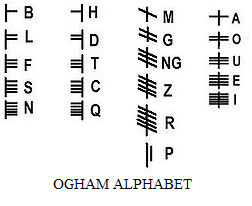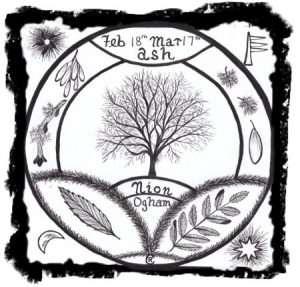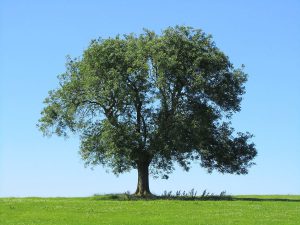Trees are said to have all different types of wisdom, mysteries magic and medicine. We know, for example, that the trees tropical rainforest yield valuable medicines familiar for thousands of years to the indigenous peoples for whom the forest remains their home. Trees have always been of paramount importance and benign value to the Celtic world.

This was true for groups all over the world throughout history, who revered the particular treasures and wisdom each species of tree had to offer in terms of shelter, energy, food, and medicine. Although it was the Celts who initiated the OGHAM. In the earliest-known form of the Ogham, the Tree-Ogham or Celtic Tree Alphabet, each letter was associated with the name of a tree. It was a secret form of written language known only to the Druid initiates. Druid’s were expected not only to memorize the history and wisdom of the Celtic peoples but also some 150 forms of the ogham alphabet, such as the Color Ogham and the Bird Ogham.


There is so much interesting information about the ogham that could easily turn into another few pages, so we will delve more into it on this website under our websites up and coming “Book Blog” section soon.
Of all the wonderful trees the Ash tree is amongst our favorite, most obviously, as we named our online bookstore after it! There are more than over 60 species of Ash to be found throughout Europe, Asia, and North America and is a member of the olive family. It is renowned throughout history by all different groups of people as being The World Tree and “Tree of Life”. It is also becoming a “timber of the working man”, favorite for craftsmen in Britain more than ever as it is less expensive than oak but still has the strength.

The Ash Tree
Nion 3rd consonant of the Ogham Alphabet 
The Common Ash is native to Northern Europe and the British Isles. It thrives on damp. lime-rich soils and is one of the main trees to be found in lowland woods. The ash is graceful, with pale gray bark and feathery leaves. Although smooth when young, the bark furrows with age, until eventually deep ridges run in ripples up the trunks of mature trees. Ash woods are light and airy and the trees grow quickly, although they tend to sour the soil around them, so other plants do not thrive there. The timber is strong and highly elastic and does not split when worked. Because the timber is extremely useful, ash woods were generally coppiced. This involved harvesting the wood by cutting the trees back to ground level every ten years or so, and allowing it to regrow. The natural lifespan of the ash is around 200 years but a single coppiced tree can live for 1,000 years or more. The ash can withstand storm-force winds because its roots grow deeply and spread for some distance around the tree, but it seems also to attract lightning, hence the expression “Avoid an ash, for it courts a flash“.

The ash’s branches grow upward, dipping down toward their ends but then rising once more so that their tips reach toward the sky. The buds of the ash are its most distinctive part. They are sooty black, covered in hairs, and have a phallic appearance. As the sap rises in spring, ash buds begin to ooze sticky resin. Strange petal-less flowers with purple stamens appear in April, long before the leaves unfurl. Flowers from box sexes, as well as hermaphrodite flowers, can occur on the same tree, and while some ashes are predominantly male, others are predominantly female. The ash bears single-winged seeds, known as keys, but it does not begin to produce fertile fruit until it is at least forty years old. The ash is one of the last trees to come into leaf in spring and it is often the first tree to lose its leaves in the fall. It has a special affinity with water and ash leaves have a triangular conduit running down their center stem, where tiny hairs absorb moisture as it trickles down the leaf.

There are over 60 species of Ash, (as mentioned above). The leaves of the Common Ash almost always have an odd number of leaflets and to find an even number is considered as lucky as finding a four-leafed clover.

Mystical Associations of the Ash
The ash is central to the beliefs of many ancient world cultures and is thought to be the tree from which the essence of humankind originated. The ash was always of great magical importance to the ancient Irish.  In the early histories of Ireland, it is said that five magical trees protected the land; three of these were ash trees, the other two were yew and oak. The magical ash trees were called the Tree of Tortu, the Tree of Dathi, and the Branching Tree of Uisnech. The Irish ollaves are said to have felled these trees themselves in 665 CE, as a symbol of the destruction of paganism by Christianity. Saint Patrick began the process in the 5th century CE, when he said to have driven all serpents out of Ireland with the aid of an ash stick.
In the early histories of Ireland, it is said that five magical trees protected the land; three of these were ash trees, the other two were yew and oak. The magical ash trees were called the Tree of Tortu, the Tree of Dathi, and the Branching Tree of Uisnech. The Irish ollaves are said to have felled these trees themselves in 665 CE, as a symbol of the destruction of paganism by Christianity. Saint Patrick began the process in the 5th century CE, when he said to have driven all serpents out of Ireland with the aid of an ash stick.  To the Celtic people. the serpent represented female earth energy and so to them, this act of Saint Patrick’s also symbolized the banishment of the goddess from involvement in the affairs of humankind.
To the Celtic people. the serpent represented female earth energy and so to them, this act of Saint Patrick’s also symbolized the banishment of the goddess from involvement in the affairs of humankind.
In Northern European legend, the ash is seen as the Great World Tree, a symbol of universality, which spreads its roots and branches over every land and forms a link between the gods, humankind, and the dead. Yggdrasill, the Enchanted Ash, marked the center of the universe, around which everything flowed. At its root was a serpent that represented female earth energies and in its crown was an eagle that was symbolic of the male energies of the sky.  In ancient Scandinavian legend, three goddesses known as the Three Norns dispensed justice from beneath the sacred ash.
In ancient Scandinavian legend, three goddesses known as the Three Norns dispensed justice from beneath the sacred ash.
The Greek Goddess Nemesis also carried an ash branch as an instrument of divine justice on behalf of the gods. She punished through humiliation those who did not show sufficient gratitude for her bounty. She and the goddesses of many other cultures measured out mortal happiness and misery under the guardianship of the ash tree.
The Vikings believed that the first man was born of the ash and their god, Odin, hung himself from this magical tree to receive illumination in the shape of the runes – an ancient form of writing similar to ogham – that contained the understanding of all the world. The Viking runes were recorded on tablets of ash and the Vikings themselves are said to have been known as Aescling, “Men of Ash,” because of their great reliance on the magic of this tree. Viking culture was quickly assimilated in Ireland and the traditional Old Irish emphasis on the earth goddesses associated with the ash tree became focused rather more than the masculine principles of the power of the sky and of the sun gods.
The ash eventually replaced the birch as the maypole, becoming a symbol of the creative life-giving energy of the sun god, instead of being a celebration of the potential of the virgin goddess as it once was.

The ash is also connected to the waters of life and is associated with the sea. In ancient Wales and Ireland, water-loving ash was always used for coracle slates and oars, and sailors carried an equal-armed cross carved from ash wood to protect them at sea. The ash is sacred to Poseidon, whose palace is beneath the ocean.
Ash was considered one of the best woods for making spears and the possession of a staff of ash was said to protect against malign influences. A Druid’s wand made from ash, found on Anglesey in North Wales, is thought to date from the early part of the 1st century CE. To the Druids, the ash holds a key to Universal Truth. It is the Tree of Balance and the Marriage of Opposites, and it links our inner and outer worlds. This bipolarity theme of balanced energies can be clearly seen in the physical properties of the ash tree. Ruled by the male energy of the sun, the ash still has a special relationship with the female element of water. The ash’s form is one of feminine grace, yet its buds are brazenly phallic and its flowers can be both bisexual or of a single sex.

In perfect harmony, the ash’s branches reach far into the sky as its roots grow into the earth. To the Celt’s, this was all symbolic of Universal Order. Like the enchanted ash, they saw themselves as an integral part of the flow of the universe. They understood that every action and thought formed part of an endless chain of events and that each and every essential part of the whole. They believed that whatever was done in the physical world would affect all other levels of existence.  The Druids represented these different levels of existence as the “Three Circles of Being” – Abred, Gwynedd, and Ceugant. These can be translated into endless trinities such as Past, Present, and Future; Physical, Mental, and Spiritual; Choas, Balance, and Creative Force. The Circles of Being are all interlinked so that whatever happens on one level will inevitably affect the other two. The Celts believed that for every action there is a reaction and that whatever we do inevitably affects everything else that might happen. We are all an important part of the Universal Order and there is no escaping the consequences of our human existence in the neverending cycle of life. For the Celts, the ash was the guardian of these universal truths.
The Druids represented these different levels of existence as the “Three Circles of Being” – Abred, Gwynedd, and Ceugant. These can be translated into endless trinities such as Past, Present, and Future; Physical, Mental, and Spiritual; Choas, Balance, and Creative Force. The Circles of Being are all interlinked so that whatever happens on one level will inevitably affect the other two. The Celts believed that for every action there is a reaction and that whatever we do inevitably affects everything else that might happen. We are all an important part of the Universal Order and there is no escaping the consequences of our human existence in the neverending cycle of life. For the Celts, the ash was the guardian of these universal truths.
Lesson of the Ash

Through their understanding of Universal Order and their appreciation of their own unique role in it, the Celts discovered a deep sense of belonging and a purpose for their existence. Our modern and hectic daily life is usually far removed from cycles and forces of the natural world, and it can often seem empty of any real purpose. The ash is a key to healing the loneliness of the human spirit out of touch with its origins – it can provide a sense of being grounded and of belonging. The ash reminded the Celts of the interlinking of the Three Cycles of Being. Likewise, we are all encouraged to consider the role of the past in creating the present so that we can better appreciate the many ways in which positive thought and action today can help create a brighter tomorrow. Through a constant process of balancing and marrying opposites, we, like the ash, can achieve harmony within ourselves.
Healing
In ancient Britain the ash was associated with rebirth and new life and was famous for its ability to heal children, who were passed through a split in the tree’s trunk in order to be cured.
The ash has some more conventional medicinal properties but its main potential for healing is in the realm of meditation. In modern kinesiology, Essence of Ash is associated with strength. It promotes harmony and a feeling of being “in tune” with your surroundings, and also gives strength and flexibility.
An infusion made from bitter ash bark is mildly is mildly laxative and diuretic. The bark from the root is considered most potent and in early medicine it was used for its tonic and astringent properties in treating liver diseases and arthritic rheumatism, Ash bark and leaves are used by herbalists today to regulate bowel movements, to expel intestinal parasites, to reduce fever, to treat kidney and urinary infections, and to alleviate rheumatic and gouty pains.
The bark if the ash has also been used as a substitute for quinine in the treatment of malaria.
Wearing garters of green ash bark was once believed to offer protection against the powers of magicians, while those who ate the buds of ash on Midsummer’s Eve were said to become invulnerable to the influence of witches. The leaves were thought to attract love and prosperity, and sleeping with fresh leaves under your pillow is said to bring psychic dreams.
The excerps above about the ash tree, are taken from this beautiful book, by Jane Gifford, is called the Wisdom of Trees. We love this book and its breathtaking photographic examinations of over 20 trees. It can be purchased here. 
We wanted to recommend this book to anyone who would enjoy reading a thorough description of each of these selected tree’s mystical associations, healing properties, folklore, and culinary uses and more. We want to celebrate this Author and give her credit as we are going to share sections below from the book. The excerpts taken from this book can be described as a rich compendium of knowledge about humankind’s historical relationship with the ash tree, throughout the ages.
We think the book is great for anyone who loves nature, interesting history intertwined with the natural world or even for someone who appreciates beautiful tree-photography as the pictures are gorgeous! It is also a great gift idea.
